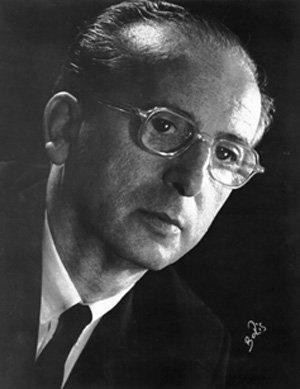Franz Waxman (Franz Waxman)

In Hollywood, Franz Waxman met James Whale, who had been highly impressed by Waxman’s score for Liliom. The success of his score for Whale’s Bride of Frankenstein (1935) led to the young composer’s appointment as Head of Music at Universal Studios. Waxman, however, was more interested in composition than musical direction for film, and in 1936 he left Universal to become a composer at MGM. Franz Waxman scored a number of pictures during the next few years, but the score for Alfred Hitchcock’s Rebecca (1940) made his name. Waxman was frequently called to work on scores of horror or suspense films, and Rebecca was the culmination of the genre for Waxman. Rebecca was Hitchcock’s first Hollywood film as part of his contract with David O. Selznick, and thus it was the first time he was allowed a full symphonic score. Selznick financed the film at the same time as he was making Gone With the Wind. Waxman’s score for Rebecca is eerie and ethereal, often setting the mood and as Jack Sullivan put it, becoming a “soundboard for the subconscious.” In 1943 Franz Waxman left MGM and moved to Warner Bros., where he worked alongside such great film composers as Max Steiner and Erich Wolfgang Korngold. A period of extended composition followed, including such films as Mr. Skeffington (1944) and Objective, Burma! (1945). A climactic scene in Objective, Burma! was scored fugally, and this would become one of Waxman’s trademarks, returning in The Spirit of St. Louis (1957) and Taras Bulba (1962). In 1947 Waxman formed the Los Angeles Music Festival, for which he served as music director and conductor for the rest of his life. Waxman’s goal with the LA Music Festival was to bring the thriving town to “European cultural standards”, according to Tony Thomas. In addition to performing the work of great masters such as Stravinsky, he also collaborated with his colleagues, such as Miklós Rózsa, conducting his Violin Concerto.
His time at Warner Brothers did not last long and by 1947 Waxman had left Warner Brothers to become a freelance film composer, taking only the jobs he wanted rather than being appointed by the studio. Franz Waxman scored the film Sorry, Wrong Number (1948), which climaxes with the use of a passacaglia, highlighting Waxman’s highly inventive use of unusual musical forms in film. Waxman had used classical forms before: the climactic “Creation” cue from The Bride of Frankenstein (1935) (as Christopher Palmer puts it) “is in effect a fantasia on one note.” His work on Sunset Boulevard (1950) led to an Academy Award. The score is fast paced and powerful, utilizing various techniques to highlight the insanity of Norma Desmond, including low pulsing notes (first heard in The Bride of Frankenstein) and frequent trills. According to Mervyn Cooke, Richard Strauss’s opera Salome was the inspiration for the wild trills heard during Desmond’s insane final performance. Franz Waxman received a second consecutive Oscar for A Place in the Sun (1951). However, while awards for film music highlighted the beginning of the 1950s, the decade is also the decade during which Waxman began to write serious works for the concert hall. The Sinfonietta for Strings and Timpani came in 1955 and 1959 saw the completion of Waxman’s oratorio Joshua. Composed to commemorate the death of Waxman’s wife, Joshua with its strong Hebrew influences and extensive use of form is a powerful example of Waxman’s compositional powers by the end of the 1950s. Waxman’s career ended with his death from cancer in February 1967, two months after his sixtieth birthday.
Born
- December, 24, 1906
- Chorzów, Poland
Died
- February, 24, 1967
- USA
- Los Angeles, California
Cause of Death
- cancer
Cemetery
- Hollywood Forever Cemetery
- Hollywood, California
- USA



